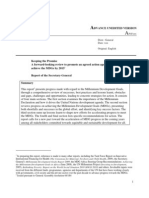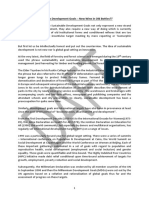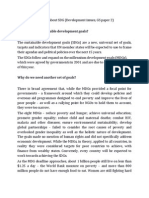CFR-Charting The Future of Global Development
CFR-Charting The Future of Global Development
Uploaded by
Vishal PandeyCopyright:
Available Formats
CFR-Charting The Future of Global Development
CFR-Charting The Future of Global Development
Uploaded by
Vishal PandeyOriginal Description:
Original Title
Copyright
Available Formats
Share this document
Did you find this document useful?
Is this content inappropriate?
Copyright:
Available Formats
CFR-Charting The Future of Global Development
CFR-Charting The Future of Global Development
Uploaded by
Vishal PandeyCopyright:
Available Formats
COUNCIL ON FOREIGN RELATIONS
Charting the Future of Global Development
by Stewart M. Patrick November 7, 2012 For more than a decade, the global conversation about development has been dominated by the Millennium Development Goals (MDGs). Established at the United Nations Millennium Summit of 2000, these eight objectives focused on what the international community could do to meet basic human needs in the developing world. Over the past dozen years the MDGs have been attacked on numerous groundsfor setting impossible goals (such as 100% primary school attendance), for neglecting critical requirements like good governance and strong institutions, and for placing unrealistic expectations on what foreign aid can actually accomplish. But whatever their shortcomings, the MDGs mobilized unprecedented global attention and financial resources for poverty alleviation, driving policy and budgetary decisions throughout the worlds aid agencies. Several of the MDGs have already been achieved (such as halving of absolute poverty) or are on track to be met by 2015. The global development community is now debating what should replace the MDGs when they expire in 2015. What is crystal clear is that the inherited MDG model is increasingly irrelevant to todays development landscape: - First, the MDG approach focuses overwhelmingly on what Western donors can do to deliver development through foreign aid. This ignores growing evidence that aid often pales in comparison to foreign investment, trade liberalization, private sector promotion, and technology transfer in laying the foundations for sustained economic growth. It also overlooks the growing role being played by non-traditional aid donors, including China, India, Brazil, and the Gulf countries, and pays insufficient attention to aligning global goals and targets to the national development priorities of the poorest countries themselves. - Second, the worlds poor are not where they were when the UN establish targets for the MDGS. In 1990the baseline date used for MDG targetsfully eighty percent of the worlds poor lived in stable, low income countries. Today, only 10 percent do, whereas nearly two-thirds (66 percent) live in middle-income countries and another quarter (24 percent) inhabit fragile or conflict-affected low-income countries. The implication? Making a dent in global poverty will require unprecedented collaboration with governments in middleincome nations, on the one hand, and new strategies to engage the worlds most conflictridden and dysfunctional countries, on the other. - Third, any successor to the MDGs must take a more comprehensive approach to development. As the UN team spearheading global consultations has concluded, follow-on goals must target not only inclusive economic and social development but also environmental sustainability (given short shrift in the MDGs) as well as peace and security (completely ignored by the MDGs, despite being a fundamental precondition for development). So what should replace the current MDGs?
The best practical answer to date comes from the Korean Development Institute (KDI) and the Canada-based Center for International Governance Innovation (CIGI), which recently released a glossy report, titled Post-2015 Development Agenda: Goals, Targets and Indicators. Dont let the soporific title fool you. This short document is an engaging, incisive and timely contribution to debates on the future development agenda. The authors eleven goals include: 1. Inclusive growth for dignified livelihoods and adequate standards of living: The KDI-CIGI initiative wisely focuses on broadly shared economic growth as the sine qua non of development. 2. Sufficient food and water for active living: This goal responds to growing concerns about water scarcity and food price volatility, as well as the need for adequate nutrition, not simply caloric intake. 3. Appropriate education and skills for full participation in society: Whereas the MDGs focused on grade school enrollment and childhood literacy, this replacement goal encompasses secondary and tertiary education. 4. Good health for the best possible physical, mental, and social well-being: The KDI-CIGI report wisely integrates all global health targets under one single goal. It also addresses not only infectious disease but the growing burden posed by non-communicable diseases. Finally, it emphasizes the importance of health system strengtheningas opposed to stove-piped, single disease interventions. 5. Security for ensuring freedom from violence: Among the MDGs biggest lacunae was inattention to human insecurity (including war, crime, and domestic violence) as a limiting factor to development. Closing this gap is critical, particularly in engaging fragile states. 6. Gender equality enabling men and women in society to participate and benefit equally in society: Reflecting the importance of women in the development process, the report calls for steps to advance the physical, economic, and decision making autonomy of women across societies. 7. Resilient communities and nations through disaster risk reduction: Growing global vulnerability to natural disastersranging from drought to hurricanes underlines the need for all societies to invest in preparedness and recovery systems. 8. Quality infrastructure for universal access to energy, transportation and communication: In an age of globalization, development depends on connectivity. The authors thus include targets for increased access to energy, transportation networks, and communications technology. 9. Empowering people to realize their civil and political rights: This proposed goal is both the most controversial and the most important. While authoritarian regimes may bluster, long-term development requires that people participate in the political process, possess civil rights, have access to rule of law, and can hold their governments accountable. 10. Sustainable management of the biosphere, enabling people and the planet to thrive together: Building on the Rio+20 conference, the authors propose steps to break from business as usual, including putting a price on the ecological costs of economic activity. 11. Global governance and equitable rules for realizing human potential: Finally, the report proposes sweeping reform of international institutions to advance development globally. This potential agenda is so massive and complex that the authors might wish to limit themselves to an even ten goals or focus on
specific shortcomings in the global economy that represent enormous barriers to development. One of the reports most distinctiveand perhaps controversialrecommendations is that progress toward these goals be measured in all countries, including advanced market democracies. While one can imagine outcries from some sovereignty-minded conservatives about being judged by the international community, there is no reason the United States should not voluntarily embrace, domestically, a set of universal, non-binding goals for human betterment broadly consistent with its own political and economic idealsas well as the development agenda it has long pursued abroad. After all, as philosopher Amartya Sen has written, the most compelling definition for development is freedom.
You might also like
- ACR-SPG ElectionDocument9 pagesACR-SPG ElectionARACELI VICERANo ratings yet
- SDGs Questions and Answers PDFDocument7 pagesSDGs Questions and Answers PDFjohnson ndabaNo ratings yet
- Vargas Llosa (El Nacimiento Del Peru)Document8 pagesVargas Llosa (El Nacimiento Del Peru)priscilasosaNo ratings yet
- Hrisovul Nr3 1943 SacerdoteanuAurelianDocument168 pagesHrisovul Nr3 1943 SacerdoteanuAurelianalberto1carlos-4100% (1)
- Development JusticeDocument12 pagesDevelopment JusticejohnpaulcorpusNo ratings yet
- Study Guide DC 2014Document16 pagesStudy Guide DC 2014komahiumyNo ratings yet
- MDG IgyvendinimasDocument34 pagesMDG IgyvendinimasAlfredasNo ratings yet
- The MDGs and The PhilippinesDocument13 pagesThe MDGs and The PhilippinesErie Said100% (1)
- Communication For Social Change, Referred To As Communication For Sustainable SocialDocument45 pagesCommunication For Social Change, Referred To As Communication For Sustainable SocialMa. Rochelle CabralesNo ratings yet
- The MDGs and The PhilippinesDocument13 pagesThe MDGs and The PhilippinesczhanelleicioussNo ratings yet
- Millennium Development GoalsDocument60 pagesMillennium Development Goalsprogov08100% (7)
- People's Health Movement Health in The Post-2015 Development AgendaDocument4 pagesPeople's Health Movement Health in The Post-2015 Development AgendaJPNo ratings yet
- Topics SeDocument52 pagesTopics SeHafsaNo ratings yet
- Analysis of The SDG ReportDocument26 pagesAnalysis of The SDG ReportSangita DubukwadNo ratings yet
- Human Welfare Development Theory GR12i 1Document11 pagesHuman Welfare Development Theory GR12i 1shilmisahinNo ratings yet
- MDGs and UN AssignmentDocument2 pagesMDGs and UN AssignmentArooj MalikNo ratings yet
- Making Globalization Work For All: Development Programme One United Nations Plaza New York, NY 10017Document48 pagesMaking Globalization Work For All: Development Programme One United Nations Plaza New York, NY 10017Bagoes Muhammad100% (1)
- Why The MDG'S Are ImportantDocument14 pagesWhy The MDG'S Are ImportantFrost BiteNo ratings yet
- Managerial EconomicsDocument20 pagesManagerial Economicsstephen blurryNo ratings yet
- From MDGs To SDGsDocument7 pagesFrom MDGs To SDGsLinn LattNo ratings yet
- 528CEB 2012 1 RioStatement 17april2012Document4 pages528CEB 2012 1 RioStatement 17april2012Carol LópezNo ratings yet
- Chaters 10 and 12 OutlinesDocument40 pagesChaters 10 and 12 Outlinessanay siswawalaNo ratings yet
- Draft Framework of Sustainable Development1Document22 pagesDraft Framework of Sustainable Development1Gaurav ShastriNo ratings yet
- Sustainable Development Goals - New Wine in Old BottlesDocument5 pagesSustainable Development Goals - New Wine in Old BottlesSuraj KumarNo ratings yet
- Fundamentals of Development-1 Group 5Document5 pagesFundamentals of Development-1 Group 5Newton OrwongoNo ratings yet
- Millennium Development GoalsDocument16 pagesMillennium Development GoalsCSSNo ratings yet
- Article For CHOGM07Document5 pagesArticle For CHOGM07amilhNo ratings yet
- Bahan Bacaan SdgsDocument7 pagesBahan Bacaan SdgsAdzan 45No ratings yet
- Sustainable Development Goals-1Document11 pagesSustainable Development Goals-1Muhammad Haseeb HassanNo ratings yet
- MapehDocument5 pagesMapehKristine Janelle OmegaNo ratings yet
- The Making of A Seoul Development Consensus: The Essential Development Agenda For The G20Document14 pagesThe Making of A Seoul Development Consensus: The Essential Development Agenda For The G20OxfamNo ratings yet
- Towards Rio+20: Population Dynamics and Sustainable DevelopmentDocument4 pagesTowards Rio+20: Population Dynamics and Sustainable DevelopmentPankaj KumarNo ratings yet
- Un PDFDocument216 pagesUn PDFkhalidomaarNo ratings yet
- Chapter 15 Shyami Puvimanasinghe and Mihir Kanade RTD Global Solidarity Shared Responsibility - Covid 19Document30 pagesChapter 15 Shyami Puvimanasinghe and Mihir Kanade RTD Global Solidarity Shared Responsibility - Covid 19MichelMazaNo ratings yet
- SDGs and MDGsDocument16 pagesSDGs and MDGsjayanti.raj21No ratings yet
- Progressive Governance Summit CommuniqueDocument7 pagesProgressive Governance Summit Communiqueprogov08No ratings yet
- Millennium Summit United Nations Millennium DeclarationDocument13 pagesMillennium Summit United Nations Millennium DeclarationMahesh InakhiyaNo ratings yet
- Economic Policies For Human Development A Neglected DomainDocument10 pagesEconomic Policies For Human Development A Neglected DomainMiha ChiribucaNo ratings yet
- What Is Development? NEWDocument6 pagesWhat Is Development? NEWRonNo ratings yet
- All You Need To Know About SDGDocument6 pagesAll You Need To Know About SDGAadiNo ratings yet
- Regional Planning LECTURE 3 - Print - 123444Document66 pagesRegional Planning LECTURE 3 - Print - 123444zuberi hamzaNo ratings yet
- Role of Civil Society Organisations in GovernanceDocument2 pagesRole of Civil Society Organisations in GovernanceNajimNo ratings yet
- UNECA Macro Training 4Document54 pagesUNECA Macro Training 4Nursing RishiNo ratings yet
- Report of the Inter-agency Task Force on Financing for Development 2020: Financing for Sustainable Development ReportFrom EverandReport of the Inter-agency Task Force on Financing for Development 2020: Financing for Sustainable Development ReportNo ratings yet
- Covepage of DavidDocument19 pagesCovepage of DavidANGELINA EMMANUELNo ratings yet
- From Poverty To Empowerment Executive Summary September 2023Document40 pagesFrom Poverty To Empowerment Executive Summary September 2023Suparna Aryabrata MozumdarNo ratings yet
- Class 23 Rio+20Document3 pagesClass 23 Rio+20ज़हीर खान मेवNo ratings yet
- MDG and SDGDocument3 pagesMDG and SDGKookie BTS100% (1)
- Grren Economyart04 - 212Document9 pagesGrren Economyart04 - 212Marcelo PignatariNo ratings yet
- 2029BAKUAzerbaijan en VersionDocument18 pages2029BAKUAzerbaijan en VersionM HabibiNo ratings yet
- UN-Report High Level Panel On Post-2015 Development AgendaDocument81 pagesUN-Report High Level Panel On Post-2015 Development AgendaAdhityani Dhitri PutriNo ratings yet
- Democracy and Development: The Global PolityDocument11 pagesDemocracy and Development: The Global Politymgenimkubwa85No ratings yet
- It Is Just About Time For Yet Another Round of International Development GoalsDocument5 pagesIt Is Just About Time For Yet Another Round of International Development GoalsIwan Adi RatmokoNo ratings yet
- Social Development Uncertain WorldDocument24 pagesSocial Development Uncertain Worldmillian0987No ratings yet
- ECOSOC - Background PaperDocument8 pagesECOSOC - Background PaperAna Paula Marin MonteroNo ratings yet
- EcoDev ReviewerDocument9 pagesEcoDev ReviewerJewel YutucNo ratings yet
- Study Guide - UNDP - International MUN Online Conference 161.0Document13 pagesStudy Guide - UNDP - International MUN Online Conference 161.0sanvismdNo ratings yet
- Chapter VIDocument8 pagesChapter VIRheineNo ratings yet
- SDGsDocument11 pagesSDGsZafar AliNo ratings yet
- Isu Pembangunan Di Tengah PandemiDocument26 pagesIsu Pembangunan Di Tengah PandemiDrefinia Nova LNo ratings yet
- Group 7 Div DDocument18 pagesGroup 7 Div DAnmol ParEekNo ratings yet
- Mdgs PhbsDocument19 pagesMdgs PhbsFranesia DwirahmanaNo ratings yet
- Week 1 - Chapter 1 - Introduction To Sustainable Enterprise and InnovationDocument17 pagesWeek 1 - Chapter 1 - Introduction To Sustainable Enterprise and InnovationAfaf AnwarNo ratings yet
- تطور قطاع الخدمات في الجزائرDocument328 pagesتطور قطاع الخدمات في الجزائرAmira SabrinelNo ratings yet
- SOCIAL SCIENCE (1-200 Items)Document33 pagesSOCIAL SCIENCE (1-200 Items)Hazel Nim BaylonNo ratings yet
- TIMELINE: Grace Poe's Citizenship, ResidencyDocument22 pagesTIMELINE: Grace Poe's Citizenship, ResidencyAlyssa Clarizze MalaluanNo ratings yet
- Industrial Relation & Labour Laws AssignmentDocument13 pagesIndustrial Relation & Labour Laws AssignmentWEDAY LIMITEDNo ratings yet
- Socialism: Notes Based On Baradat (2012) and Festenstein and Kenny (2010)Document23 pagesSocialism: Notes Based On Baradat (2012) and Festenstein and Kenny (2010)Humayun RandhawaNo ratings yet
- Marxism and LyricDocument13 pagesMarxism and LyricAkshay KaleNo ratings yet
- Chuck Yeager's Crash Landing in Pakistan - The Right Stuff in The Wrong PlaceDocument7 pagesChuck Yeager's Crash Landing in Pakistan - The Right Stuff in The Wrong PlaceLuptongaNo ratings yet
- Vol.8 Issue 13 - August 1-7, 2015Document32 pagesVol.8 Issue 13 - August 1-7, 2015Thesouthasian TimesNo ratings yet
- Mison Vs NatividadDocument1 pageMison Vs NatividadOlivia FelNo ratings yet
- Some of The Major Sins or Kaba'ir in Islam Are As FollowsDocument4 pagesSome of The Major Sins or Kaba'ir in Islam Are As FollowsOnemandynestyNo ratings yet
- 1K Tiền Gửi HSBC 2022Document50 pages1K Tiền Gửi HSBC 2022ngoc bichNo ratings yet
- Defining and Surveying Heroism by Michael "Xiao" Chua, January 20, 2018Document5 pagesDefining and Surveying Heroism by Michael "Xiao" Chua, January 20, 2018the architographerNo ratings yet
- Mock Supreme Court Rubric 2017 1Document1 pageMock Supreme Court Rubric 2017 1api-370229453No ratings yet
- Leo Gross The Peace of WestphaliaDocument23 pagesLeo Gross The Peace of WestphaliaAdri.No ratings yet
- Steinem, If Men Could MenstruateDocument9 pagesSteinem, If Men Could Menstruatesrishti3069No ratings yet
- Barclays Venezuela The Fall of The MythsDocument9 pagesBarclays Venezuela The Fall of The MythsJohann Starchevich Pineda0% (1)
- Appeal No. 2085 of 2015 Filed by Mr. Ravi Ramaiya.Document2 pagesAppeal No. 2085 of 2015 Filed by Mr. Ravi Ramaiya.Shyam SunderNo ratings yet
- Russian History TimelineDocument27 pagesRussian History Timelineapi-278204574No ratings yet
- Miller David ComplaintDocument14 pagesMiller David ComplaintSteve SchaeferNo ratings yet
- Investment LawDocument14 pagesInvestment LawShirat MohsinNo ratings yet
- DiPaolo Flappers 2013Document11 pagesDiPaolo Flappers 2013meanfiddlerNo ratings yet
- PETITION-IN-INTERVENTION DavideDocument77 pagesPETITION-IN-INTERVENTION DavideJudge Florentino FloroNo ratings yet
- Dates Fresh and Dried Sector 2021Document13 pagesDates Fresh and Dried Sector 2021FileuploaderNo ratings yet
- dataPDM-2Document136 pagesdataPDM-2Chandra ArisandyNo ratings yet
- Food Corporation of India (Fci)Document14 pagesFood Corporation of India (Fci)Sourav SharmaNo ratings yet
- Technical Communication - Edward TufteDocument16 pagesTechnical Communication - Edward TufteDennis MayrNo ratings yet
- Weill Ross Framework PDF 99126Document11 pagesWeill Ross Framework PDF 99126tbeyrutNo ratings yet

























































































